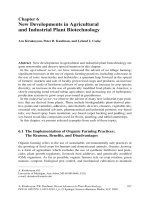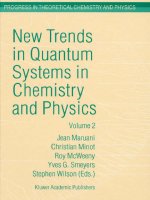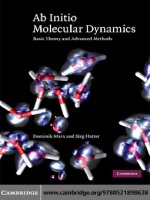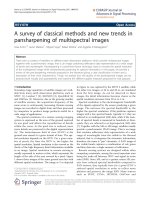- Trang chủ >>
- Khoa Học Tự Nhiên >>
- Vật lý
NEW TRENDS IN QUANTUM SYSTEMS IN CHEMISTRY AND PHYSICS ppt
Bạn đang xem bản rút gọn của tài liệu. Xem và tải ngay bản đầy đủ của tài liệu tại đây (8.07 MB, 324 trang )
NEW TRENDS IN QUANTUM SYSTEMS
IN CHEMISTRY AND PHYSICS
Progress in Theoretical Chemistry and Physics
-
VOLUME 7
W. N. Lipscomb (Harvard University, Cambridge, MA, U. S. A.)
I. Prigogine (Université Libre de Bruxelles, Belgium)
Editors-in-Chief:
J. Maruani (Laboratoire de Chimie Physique, Paris, France)
S. Wilson (Rutherford Appleton Laboratory, Oxfordshire, United Kingdom)
Editorial Board:
H
. Ågren (Royal Institute of Technology, Stockholm, Sweden)
D. Avnir (Hebrew University of Jerusalem, Israel)
J. Cioslowski (Florida State University, Tallahassee, FL, U.S.A.)
R. Daudel (European Academy of Sciences, Paris, France)
E.K.U. Gross (Universität Würzburg Am Hubland, Germany)
W.F. van Gunsteren (ETH-Zentrum, Zürich, Switzerland)
K. Hirao (University of Tokyo, Japan)
I. Hubac (Komensky University, Bratislava, Slovakia)
M.P. Levy (Tulane University, New Orleans, LA, U.S.A.)
G.L. Malli (Simon Frazer University, Burnaby, BC, Canada)
R. McWeeny (Università di Pisa, Italy)
P.G. Mezey (University of Saskatchewan, Saskatoon, SK, Canada)
M.A.C. Nascimento (Instituto de Quimica, Rio de Janeiro, Brazil)
J. Rychlewski (Polish Academy of Science, Poznan, Poland)
S.D. Schwartz (Yeshiva University, Bronx, NY, U.S.A.)
Y.G. Smeyers (Instituto de Estructura de la Materia, Madrid, Spain)
S . Suhai (Cancer Research Center, Heidelberg, Germany)
O. Tapia (Uppsala University, Sweden)
P.R. Taylor (University of California, La Jolla, CA, U.S.A.)
R.G. Woolley (Nottingham Trent University, United Kingdom)
The titles published in this series are listed at the end of this volume.
Honorary Editors:
-
New Trends in Quantum
Systems in Chemistry
and Physics
Volume
2
Advanced Problems and Complex Systems
Paris, France,
1999
Edited
by
Jean Maruani
CNRS, Paris, France
Christian Minot
UPMC, Paris, France
Roy McWeeny
Università di
Pisa,
Italy
Yves G. Smeyers
CSIC,
Madrid,
Spain
and
Stephen Wilson
Rutherford Appleton Laboratory,
Oxfordshire, United Kingdom
KLUWER ACADEMIC PUBLISHERS
DORDRECHT / BOSTON / LONDON
/ NEW YORK / MOSCOW
eBook ISBN: 0-306-46950-2
Print ISBN: 0-306-46447-0; 0-7923-6710-3 (set)
©2002 Kluwer Academic Publishers
New York, Boston, Dordrecht, London, Moscow
All rights reserved
No part of this eBook may be reproduced or transmitted in any form or by any means, electronic,
mechanical, recording, or otherwise, without written consent from the Publisher
Created in the United States of America
Visit Kluwer Online at:
and Kluwer's eBookstore at:
Progress in Theoretical Chemistry and Physics
A
series reporting advances in theoretical molecular
and
material
sciences, including theoretical, mathematical
and
computational
chemistry, physical chemistry and chemical physics
Aim
and
Scope
Science progresses by a symbiotic interaction between theory and experiment: theory is
used to interpret experimental results and may suggest new experiments; experiment
helps to test theoretical predictions and may lead to improved theories. Theoretical
Chemistry (including Physical Chemistry and Chemical Physics) provides the concep
-
tual and technical background and apparatus for the rationalisation of phenomena in the
chemical sciences. It is, therefore, a wide ranging subject, reflecting the diversity of
molecular and related species and processes arising in chemical systems. The book
series Progress in Theoretical Chemistry and Physics aims to report advances in
methods and applications in this extended domain. It will comprise monographs as well
as collections of papers on particular themes, which may arise from proceedings of
symposia or invited papers on specific topics as well as initiatives from authors or
translations.
The basic theories of physics - classical mechanics and electromagnetism, relativity
theory, quantum mechanics, statistical mechanics, quantum electrodynamics - support
the theoretical apparatus which is used in molecular sciences. Quantum mechanics
plays a particular role in theoretical chemistry, providing the basis for the valence
theories which allow to interpret the structure of molecules and for the spectroscopic
models employed in the determination of structural information from spectral patterns.
Indeed, Quantum Chemistry often appears synonymous with Theoretical chemistry: it
will, therefore, constitute a major part of this book series. However, the scope of the
series will also include other areas of theoretical chemistry, such as mathematical
chemistry (which involves the use of algebra and topology in the analysis of molecular
structures and reactions); molecular mechanics, molecular dynamics and chemical
thermodynamics, which play an important role in rationalizing the geometric and
electronic structures of molecular assemblies and polymers, clusters and crystals;
surface, interface, solvent and solid-state effects; excited-state dynamics, reactive
collisions, and chemical reactions.
Recent decades have seen the emergence of a novel approach to scientific research,
based on the exploitation of fast electronic digital computers. Computation provides a
method of investigation which transcends the traditional division between theory and
experiment. Computer
-
assisted simulation and design may afford a solution to complex
problems which would otherwise be intractable to theoretical analysis, and may also
provide a viable alternative to difficult or costly laboratory experiments. Though
stemming from Theoretical Chemistry, Computational Chemistry is a field of research
v
Progress in Theoretical Chemisty and Physics
in its own right, which can help to test theoretical predictions and may also suggest
improved theories.
The field of theoretical molecular sciences ranges from fundamental physical
questions relevant to the molecular concept, through the statics and dynamics of
isolated molecules, aggregates and materials, molecular properties and interactions, and
the role of molecules in the biological sciences. Therefore, it involves the physical basis
for geometric and electronic structure, states of aggregation, physical and chemical
transformations, thermodynamic and kinetic properties, as well as unusual properties
such as extreme flexibility or strong relativistic or quantum-field effects, extreme
conditions such as intense radiation fields or interaction with the continuum, and the
specificity of biochemical reactions.
Theoretical chemistry has an applied branch – a part of molecular engineering,
which involves the investigation of structure-property relationships aiming at the
design, synthesis and application of molecules and materials endowed with specific
functions, now in demand in such areas as molecular electronics, drug design or genetic
engineering. Relevant properties include conductivity (normal, semi
-
and supra
-
),
magnetism (ferro
-
or ferri
-
), optoelectronic effects (involving nonlinear response),
photochromism and photoreactivity, radiation and thermal resistance, molecular recog
-
nition and information processing, and biological and pharmaceutical activities, as well
as properties favouring self
-
assembling mechanisms and combination properties needed
in multifunctional systems.
Progress in Theoretical Chemistry and Physics is made at different rates in these
various research fields. The aim of this book series is to provide timely and in
-
depth
coverage of selected topics and broad
-
ranging yet detailed analysis of contemporary
theories and their applications. The series will be of primary interest to those whose
research is directly concerned with the development and application of theoretical
approaches in the chemical sciences. It will provide up
-
to
-
date reports on theoretical
methods for the chemist, thermodynamician or spectroscopist, the atomic, molecular or
cluster physicist, and the biochemist or molecular biologist who wish to employ
techniques developed in theoretical, mathematical or computational chemistry in their
research programmes. It is also intended to provide the graduate student with a readily
accessible documentation on various branches of theoretical chemistry, physical chem
-
istry and chemical physics.
Contents
Preface ix
Part
VI.
Response Theory: Properties and Spectra
On
gauge invariance and molecular electrodynamics
3
R.G.
Woolley
Quantum mechanics of electro-nuclear systems - Towards a theory of
chemical reactions
23
O. Tapia
Theoretical study
of
regularities in atomic and molecular spectral
properties
49
I. Martín, C. Lavín and E. Charro
Excited states of hydrogen peroxide: an overview
65
P. K. Mukherjee, M. L. Senent and Y. G. Smeyers
On electron dynamics in violent cluster excitations
85
P. G. Reinhard and E. Suraud
Relativistic effects in non-linear atom-laser interactions at ultrahigh
intensities
107
V. Véniard, R. Taïeb, C. Szymanowski and A. Maquet
Part
VII
-
Reactive Collisions and Chemical Reactions
Semiclassical close
-
coupling description of electron transfer in multi
-
charged ion-atom collisions
121
J. Caillat, A. Dubois and J. P. Hansen
Single and double electron capture in boron collision systems
133
M. C Bacchus
-
Montabonel and P. Honvault
vii
viii
Theoretical study of the interaction of carbon dioxide with Sc, Ti, Ni,
and Cu atoms 143
F. Mele, N. Russo, M. Toscano and F. Illas
Part VIII. Condensed Matter
Recurrent variational approach applied to the electronic structure of
conjugated polymers
169
Effects of solvation for (R,R) tartaric-acid amides
189
M. Hoffmann and J. Rychlewski
Interpretation of vibrational spectra in electrochemical environments
from first-principle calculations: computational strategies 211
Excited states in metal oxides by configuration interaction and multi
-
reference perturbation theory
227
C. Sousa, C. de Graaf, F. Illas and G. Pacchioni
Electrostatic effects in the heterolytic dissociation of hydrogen at mag-
nesium oxide 247
C. Pisani and A. D’Ercole
A DFT study of CO adsorption on Ni
II
ions 3-fold coordinated to silica 257
D. Costa, M. Kermarec, M. Che, G. Martra, Y. Girard and P. Chaquin
A theoretical study of structure and reactivity of titanium chlorides
269
C. Martinsky and C. Minot
Phenomenological description of D
-
wave condensates in high
-
T
c
super
-
conducting cuprates
289
E. Brändas, L.J. Dunne and J. N. Murrell
Contents of Volume 1
305
Combined Index to Volumes 1 and 2
309
S. Pleutin,
E.
Jeckelmann, M.A. Martín
-
Delgado and G. Sierra
M. García-Hernández, A. Markovits, A. Clotet, J.M Ricart and F. Illas
Preface
These two volumes collect thirty
-
eight selected papers from the scientific contributions
presented at the Fourth European Workshop on Quantum Systems in Chemistry and
Physics (QSCP-IV), held in Marly-le-Roi (France) in April 22-27, 1999. A total of one
hundred and fifteen scientists attended the workshop, 99 from Europe and 16 from the
rest of the world. They discussed the state of the art, new trends, and future evolution of
the methods and applications.
The workshop was held in the old town of Marly-le-Roi, which lies to the West of
Paris between the historic centres of Saint-Germain-en-Laye and Versailles. Participants
were housed at the National Youth Institute, where over sixty lectures were given by lea
-
ding members of the scientific community; in addition, over sixty posters were presented
in
two very animated sessions. We are grateful to the oral speakers and to the poster pre
-
senters for making the workshop such an stimulating experience. The social programme
was also memorable – and not just for the closing banquet, which was held at the French
Senate House. We are sure that participants will long remember their visit to the 'Musée
des Antiquités Nationales': created by Napoleon III at the birthplace of Louis XIV, this
museum boasts one of the world finest collections of archeological artifacts.
The Marly
-
le
-
Roi workshop followed the format established at the three previous
meetings, organized by Prof. Roy McWeeny at San Miniato Monastery, Pisa (Italy) in
April, 1996 (the proceedings of which were published in the Kluwer TMOE series); Dr
Steve Wilson at Jesus College, Oxford (United Kingdom) in April, 1997 (which resulted
in two volumes in Adv. Quant. Chem.); and Prof. Alfonso Hernandez-Laguna at Los
Alixares Hotel, Granada (Spain) in April, 1998 (for which proceedings appeared in the
present series). These meetings, sponsored by the European Union in the frame of the
Cooperation in Science and Technology (COST) chemistry actions, create a forum for
discussion, exchange of ideas and collaboration on innovative theory and applications.
Quantum Systems in Chemistry and Physics encompasses a broad spectrum of re
-
search where scientists of different backgrounds and interests jointly place special em
-
phasis on quantum theory applied to molecules, molecular interactions and materials. The
meeting was divided into several sessions, each addressing a different aspect of the field:
1
-
Density matrices and density functionals; 2 - Electron correlation treatments; 3 - Re
-
lativistic formulations and effects; 4 - Valence theory (chemical bond and bond break
-
ing); 5
-
Nuclear motion (vibronic effects and flexible molecules); 6
-
Response theory
(properties and spectra); 7
-
Reactive collisions and chemical reactions, computational
chemistry and physics; and 8
-
Condensed matter (clusters and crystals, surfaces and in
-
terfaces).
Density matrices and density functionals have important roles in both the interpreta-
tion and the calculation of atomic and molecular structures and properties. The funda-
mental importance of electronic correlation in many
-
body systems makes this topic a
central area of research in quantum chemistry and molecular physics. Relativistic effects
are being increasingly recognized as an essential ingredient of studies on many
-
body sys
-
tems, not only from a formal viewpoint but also for practical applications to molecules
and materials involving heavy atoms. Valence theory deserves special attention since it
ix
x
improves the electronic description of molecular systems and reactions from the point of
view used by most laboratory chemists. Nuclear motion constitutes a broad research field
of great importance accounting for the internal molecular dynamics and spectroscopic
properties.
Also very broad and of great importance in physics and chemistry is the topic of re-
sponse theory, where electric and magnetic fields interact with matter. The study of che-
mical reactions and collisions is the cornerstone
of
chemistry, where traditional concepts
like potential-energy surfaces or transition complexes appear to become insufficient, and
the new field of computational chemistry finds its main applications. Condensed matter is
a field in which progressive studies are performed, from few-atom clusters to crystals,
surfaces and materials.
We are pleased to acknowledge the support given to the Marly-le-Roi workshop by
the European Commission, the Centre National de la Recherche Scientifique (CNRS)
and Université Pierre et Marie Curie (UPMC). We would like to thank Prof. Alfred Ma-
quet, Director of Laboratoire de Chimie Physique in Paris, Prof. Alain Sevin, Director of
Laboratoire de Chimie Théorique in Paris, and Dr Gérard Riviére, Secretary of COST-
Chemistry in Brussels, for financial and logistic help and advice. Prof. Gaston Berthier,
Honorary Director of Research, and Prof. Raymond Daudel, President of the European
Academy, gave the opening and closing speeches. The supportive help of Ms Françoise
Debock, Manager of INJEP in Marly-le-Roi, is also gratefully acknowledged. Finally, it
is a pleasure to thank the work and dedication of all other members of the local organiz-
ing team, especially Alexandre Kuleff, Alexis Markovits, Cyril Martinsky and, last but
not least, Ms Yvette Masseguin, technical manager of the workshop.
Jean Maruani and Christian Minot
Paris, 2000
Part VI
Response Theory:
Properties and Spectra
This page intentionally left blank.
ON GAUGE INVARIANCE AND MOLECULAR ELECTRODYNAMICS
R. G. WOOLLEY
Department of Chemistry and Physics,
Nottingham Trent University,
Clifton Lane, Nottingham NG11 8NS, U.K.
Abstract.
A general account of the interaction of electric charges with electromag-
netic radiation is presented, the charges being treated in the non-relativistic approxi-
mation. The two main approaches in the literature, based on either the potentials of
the electromagnetic field (
'
minimal coupling' ) or the polarization fields of the char
-
ges (e.g., the 'multipolar Hamiltonian') are presented in a unified framework, that
characterizes them as simply different viewpoints of the same general structure. This
structure is very suitable for a discussion of the gauge invariance of the theory. The
final quantum mechanical Hamiltonian presented here has recently been shown to
provide the basis for a proof of the gauge invariance of its associated S
-
matrix to all
orders of perturbation theory, provided the S
-
matrix is taken on the energy
-
shell.
Some outstanding problems are described briefly.
1. Introduction
The quantum theory of atoms and molecules interacting with electromagnetic radia-
tion has a very long history; it was the subject of the first successful attempts at field
quantization in the late 1920's. It has been presented in a variety of ways of which
only two have become well-known. Firstly, there is the 'minimal coupling' form
using a vector potential for the radiation, generally subject to the Coulomb gauge
condition. There is also the 'multipolar Hamiltonian' in which electric and magnetic
multipole moments are coupled directly to the (transverse) electric and magnetic
fields. This latter form can be generalized by replacing the multipole series by clo-
sed form 'polarization fields', and when this is done one sees that the polarization
fields are subject to the same kind of arbitrariness as that implied by the gauge trans
-
formations of the vector potential. Some definite choice of vector potential, or of the
polarization fields, has always seemed necessary in order to have a practical scheme
for calculations of absorption, emission and scattering phenomena; it is thus crucial
to decide what calculations can be made that are independent of the choices made
3
J.
Maruani et al. (eds.), New Trends in Quantum Systems in Chemistry and Physics, Volume
2,
3
-
21.
© 2000
Kluwer Academic Publishers. Printed in the Netherlands.
4 R. G. WOOLLEY
for the gauge (or the polarization fields), and for this one needs a suitably general
theory.
In covariant QED gauge invariance is a straightforward matter; the field potential
occurs coupled linearly to the 4-current which satisfies the equation of continu-
ity = 0, and this means that the gauge transformations of the potential are easily
disposed of. It is therefore perhaps worth noting explicitly at the outset why there is
something to discuss for the non-relativistic theory. The point is simply that in mole-
cular electrodynamics we do not calculate with the covariant formalism and take the
non
-
relativistic limit at the end. Instead we start again with the atomic/molecular Ha
-
miltonian (a collection of a fixed number of charges) and the Hamiltonian for free
radiation which are coupled by a gauge-dependent interaction. The complete Hamil-
tonian is easily shown to be gauge invariant; furthermore the equation of continuity
must still be satisfied but it does not seem possible to use it straightforwardly as in
covariant QED to show that perturbation theory is gauge invariant, and as we shall
see there are examples in the literature of gauge-dependent perturbation calculations
(e.g., of spectral lineshapes).
This paper presents an account of the dynamics of electric charges coupled to
electromagnetic fields. The main approximation is to use non-relativistic forms for
the charge and current density. A quantum theory requires either a Lagrangian or a
Hamiltonian formulation of the dynamics; in atomic and molecular physics the latter
is almost universal so the main thrust of the paper is the development of a general
Hamiltonian. It is this Hamiltonian that provides the basis for a recent demonstration
that the S-matrix on the energy shell is gauge
-
invariant to all orders of perturbation
theory.
2.
Charges, currents and polarization fields
In electrodynamics the coupling between matter and the electromagnetic field is me-
diated by the charge density, p(x,t), and the current density, j(x,t), which together
satisfy an equation of continuity,
(1)
that expresses local conservation of charge. In the electrodynamics of bulk matter it
is usual to express the charge and current density in terms of two polarization fields.
In the classical formulation of Lorentz
[1]
this description has a definite physical
motivation, being accompanied by an explicit division of the charges into 'bound'
and 'free' charge densities. But we shall not make any assumptions here about loca-
lization; thus we write
MOLECULAR ELECTRODYNAMICS 5
(2a)
(2b)
with p(x,t) being the total charge density. Equation (2) is to be taken to apply to a
single charge, and then extended by linearity to a collection of N charges. These are
classical equations which eventually will have to be reinterpreted as operator rela
-
tions for a quantum theory; the polarization fields will become operators, because
p(x,t) and j(x,t) do. We retain the classical terminology however; thus P(x,t) and
M(x,t) are called the electric polarization and magnetic polarization ('magnetiza
-
tion') fields respectively. Such a polarization field description has commonly been
regarded as being particularly 'physical' or 'natural' (e.g. through its multipolar re
-
presentation) even though the pair {P, M} are not defined uniquely by (2) [2]. It
should be noted that in a quantum theory the distinction between 'bound' and 'free'
charges is one that is carried by the solutions of the Schrödinger equation for the
charges (bound
-
state versus continuum wavefunctions) and is not directly associated
with the operators in the Schrödinger representation we anticipate using in atomic
and molecular physics.
To begin with we concentrate on equation (2a), which is purely static. We define
the Green’s function g(x,x') for the divergence operator:
(3)
in terms of which a formal solution of (2a) is
(4)
Here p(x,t) for point charges can be expressed as a sum of Dirac delta functions in
the usual way. The longitudinal component of g
is well
-
defined; it can be written as
[3]:
(5)
Although the differential equation (3) is consistent with solutions involving (x -
x’), these are only a subset of the solution set, so treating x and x' as separate varia-
bles, its Fourier transform on x yields the longitudinal solution
(6)
6 R.
G.
WOOLLEY
The longitudinal component of g(p,x')is directed along p so we introduce an ortho-
gonal triad of unit vectors i = 1,2,3} with = p/
p
; then the transverse compo-
nent lies in the plane containing ,
(7)
in terms of two scalar functions f and h. Since g satisfies
(8)
f(p,x´) and h(p,x´) can behave as p
v
,
v
-1 near p = 0; otherwise their singularities
are controlled only by the requirement that the Fourier transforms required for (2)
exist. The transverse component of the Green’s function g(x,x') is thus essentially ar
-
bitrary. In view of (4) these characteristics are inherited by the longitudinal and trans
-
verse components of the electric polarization field, P(x,t) (and its transform P(p,t)).
We note specifically that the ‘long-wavelength’ limit, p
0, of P(p,t) need not
exist. A general account of the use of polarization fields in electrodynamics should
reflect this situation which may strongly constrain any proposed physical interpre-
tation.
Given a particular choice of electric polarization field, P(x,t), we can use it to
solve for M(x,t) in (2b). If j(x,t) and P(x,t) are separated into longitudinal and trans
-
verse parts, a simple calculation shows that the longitudinal contributions cancel
identically because of the equation of continuity, (1). We then find,
(9)
Equations (4) and (9) are general forms for the polarization fields which display
their arbitrary content through their dependence on the Green's function g
(
x,x
´).
3.
Electrodynamics in Lagrangian form
A Lagrangian for a collection of charged particles in an electromagnetic field can be
written down directly using the polarization fields
(10)
MOLECULAR ELECTRODYNAMICS 7
where L
p
is the kinetic energy contribution of the particles. It is easily verified with
the aid of some specific choice of the polarization fields that (10) with the Euler
-
Lagrange equations reproduces the Lorentz Force Law [4] provided that equation
(11) holds for the fields,
(11)
Suppose we adopt (4) as the general form for the electric polarization field; then the
part of the Lagrangian potential depending on E(x,t) in full is
(12)
Turning the argument round we could regard (12) as the fundamental form for this
part of the Lagrangian potential and take (4) as a convenient abbreviation for one of
the integrations that leaves the electric field explicit in the Lagrangian. We
could
as
well 'simplify' (
12)
by defining a scalar functional
of
the electric field,
(13)
and present (12) in a form with the charge density explicit,
(14)
If we put g(x,x´)
|
, e
quation (5), into (13) and call the result V
(x´,t), we have at
once,
(15)
and V(x,t) is recognized as the conventional scalar potential for the electromagnetic
field. However once there is a non
-
zero transverse component in g(x,x´), is not in
general integrable.
In similar fashion (9) with (10) yields
(16)
8 R. G. WOOLLEY
and in complete analogy with (1 2) we can introduce a vector valued functional of
the magnetic field, and express (16) in 'simplified' form with the charge and current
densities explicit. It is convenient to make an integration by parts in (16) and set
(17)
so that
(18)
The vector defined by (17) is a familiar object in electrodynamics; it is indeed
the Coulomb gauge vector potential [5], satisfying
(19)
Furthermore with the aid of (12) we verify that
(20)
Thus, if we separate the electric field into its longitudinal and transverse parts, we
easily obtain the full Lagrangian potential as
(21)
where V(x,t) satisfies (15), A(x,t) is the Coulomb gauge vector potential, (17), and
(4) has been reintroduced into the last term.
Suppose we give the vector potential a longitudinal component by writing,
(22)
(23)
where A(x,t) is the purely transverse Coulomb gauge vector potential, and
MOLECULAR ELECTRODYNAMICS 9
(so = and simultaneously transform by setting
(24)
Equations (22), (24) are usually referred to as the equations defining the gauge trans
-
formations of the scalar and vector potentials for the fields. If we set
(25)
then E(x,t) and B(x,t) so defined are unchanged by (22), (24) and automatically sa
-
tisfy the Maxwell equations (11). In terms of the arbitrary pair of potentials (a,
the Lagrangian potential has exactly the same form as (21) for the special potentials
{A, V), i.e.
(26)
is valid in any gauge, and is invariant under arbitrary gauge transformations of the
potentials. It has long been
known
that the integral in the last term of (26) is the gen
-
erator of the Power
-
Zienau
-
Woolley transformation, that relates the Coulomb gauge
and multipole Hamiltonians [6-9] with a = A, the Coulomb gauge vector potential,
and P(x,t) is given as a multipole series which may be summed into a particular line
integral form. The true significance of this integral. however, is that the time deriva
-
tive in (26) is required if the Lagrangian is to display its full invariance under arbitra-
ry gauge transformations of the potentials. It is a standard result in classical mecha
-
nics that under very mild assumptions, the addition of a total time derivative to a
Lagrangian does not affect the classical equations
of
motion; equivalently, if the
time derivative is written as dF/dt, F is the generator of a canonical (unitary) trans
-
formation in the classical (quantum) Hamiltonian formalism. For this reason the cus
-
tomary Lagrangian for charged particles in a given field is based only on the first two
terms in (26) [10].
A particular set of potentials can be specified by imposing a linear functional
constraint
on
the vector potential. Such a constraint
is
usually referred to as a gauge
condition; a general gauge condition is provided by the equation
(27)
10 R. G. WOOLLEY
which causes the total time derivative in (26) to vanish. The interpretation of this
equation is that, for every choice of the Green’s function g(x,x´), there
is
a vector
potential a(x´,t) such that (27) is true. To see how
this
works we separate the vector
that (27) gives
potential into its longitudinal (a ) and transverse (A, equation (1 7)) components, so
(28)
The left
-
hand side of (28) is just the gauge function in (23), and we can therefore say
that the vector potential specified by,
(29)
satisfies (27) identically. In this equation A(x,t) is the Coulomb gauge vector poten
-
tial which is regarded as fixed so that the gauge freedom in the potential a(x´,t) re
-
sults from the freedom to choose the transverse component of the Green's function
g(x,x´). The choice g(x,x´)
-
|
=
0
yields the Coulomb gauge vector potential,
(17),
(30)
Equation (29) is particularly useful for the quantum theory because we
know
how to
represent the Coulomb gauge vector potential operator in terms of photon annihila
-
tion and creation operators; since the Green's function g(x,x’) remains a c
-
number.
(29)
gives an operator representation of the vector potential in an arbitrary gauge.
4.
Electrodynamics in Hamiltonian form
The Lagrangian of the previous section is easily extended to give a total Lagrangian
for a closed system of charges and fields by including a contribution describing free
electromagnetic radiation. This extra term is [10]
(31)
(32)
with L
int
either as
in
(10), or (26).
The general Hamiltonian formalism was developed principally by Dirac [11-13];
so
that the total Lagrangian
has
the structure
MOLECULAR ELECTRODYNAMICS 11
its application to molecular Lagrangians of the form of (32) has been described pre-
viously [4, 7, 14, 15]. The scalar potential is a redundant variable, because its time
derivative does not appear in the Lagrangian, and is eliminated from the Hamilton
-
ian, which reads
(33)
where are the particle and field conjugate momenta respectively. They
have canonical Poisson
-
Brackets with their coordinates
(34)
At this stage the gauge of the vector potential is left free
with
the consequence that
the evolution generated by the Hamiltonian equations of motion
(35)
for any dynamical variable C, is subject to a non
-
integrable equation of constraint,
(36)
where p(x) is the charge density, and is Dirac’s 'weak equality' sign [11-13].
explicit. However when the Hamiltonian
(33)
is cast in the form
In
atomic and molecular physics we require the Coulomb energies to be made
(37)
the terms in (37) are individually gauge dependent. The principle of gauge invariance
claims that physical observables must be independent of the choice of gauge, so it is
important to consider how gauge invariance of calculated quantities can be establi
-
shed. First however we must deal with the constraint (36).
To do this we bring in another equation of constraint which has the property that
its Poisson bracket with does not vanish. In Dirac's terminology, this yields a
canonical scheme with two second
-
class constraints. The extra constraint can be ta
-
12 R.
G.
WOOLLEY
ken to be the general gauge condition (27), so the
two
second
-
class constraints are
(38a)
(38b)
Their mutual Poisson brackets calculated using (34) yield a non
-
singular matrix with
elements
(39)
Its inverse is given by
(40)
The Dirac bracket of two dynamical variables j and k which we write as [j,k]* is de-
fined using this inverse matrix as
(41)
the brackets on the rhs being calculated using (34). Using (39)
-
(4 1) shows that the
Dirac bracket of any dynamical variable with a constraint
i = 1, 2) vanishes
identically. The non-zero Dirac brackets of the variables in the Hamiltonian (33) are
easily found to be:
(42a)
(42b)
(42c)
The Dirac brackets are like the original Poisson brackets, being antisymmetric and
satisfying the Jacobi identity, and are the
basis
for quantization using the usual cor
-
respondence [11-13]
(43)
We can now set
MOLECULAR ELECTRODYNAMICS
13
= = 0
(44)
as the condition that fixes the gauge of the vector potential in the Hamiltonian
(33),
and in (42), according to the choice of the Green's function g
(
x,x
´).
The gauge con
-
dition (44) implies that the vector potential in any gauge can be represented in terms
of the purely transverse Coulomb gauge vector potential, A(x.t), and the Green's
function as in (29),
in terms of the Dirac bracket (42b). The operator properties of a(x,t) can therefore
be implemented through the operator representation of A(x,t). while its arbitrariness
is carried by the c
-
number g(x,x´). Accordingly, we write the quantum theory in
terms of A(x,t) and its conjugate and we then have to establish what kind of calcula-
tions can be carried out that yield answers independent of the arbitrary Green's func-
tion g(x,x´). We see from (42) that every gauge has
its
own set of Dirac brackets;
correspondingly after quantization, every gauge has its own set of commutation re
-
lations and its own Hilbert space. Since canonical (unitary) transformations should
leave the Dirac brackets (commutators) invariant, the passage
from
one gauge to
another cannot be effected by such transformations. Hence we shall not be able to
rely on the nice properties of canonical (unitary) transformations in seeking to check
gauge invariance.
The properties of the dynamical variables are fixed by the brackets (42), and it is
easily verified that separating as
= + P(x)
(45)
is consistent with (42) if
is
interpreted as the conjugate of the Coulomb gauge
vector potential A(x) (associated purely with electromagnetic radiation), and P(x) is
the electric polarization field given by (4). We complete the identification of by
computing its equation of motion; using (33), (35) and (42) we obtain,
independently of the gauge,
(46)
so that the conjugate momentum can be recognized as the total electric field, to
14
R. G. WOOLLEY
within a constant, =
-
E(x,t), i.e. (46) is one of Maxwell's equations.
can be written as
With this identification of the transverse field variables, the second term in (33)
(47)
where is determined
by
(45).
The first term in (47) is the Hamiltonian for ra
-
diation, which after quantization can be interpreted in terms
of
photons in the usual
way [6]:
(48)
The term in (47) linear in can be put in the form:
(49)
using (4), and so couples charges to electromagnetic radation via the (arbitrary)
transverse part of the Green's function g(x,r
a
). Finally, if we define
(50)
the last term in (47) is
(51)
again using (4). With the aid of (5) the longitudinal part of the Green's function
yields
(52)









